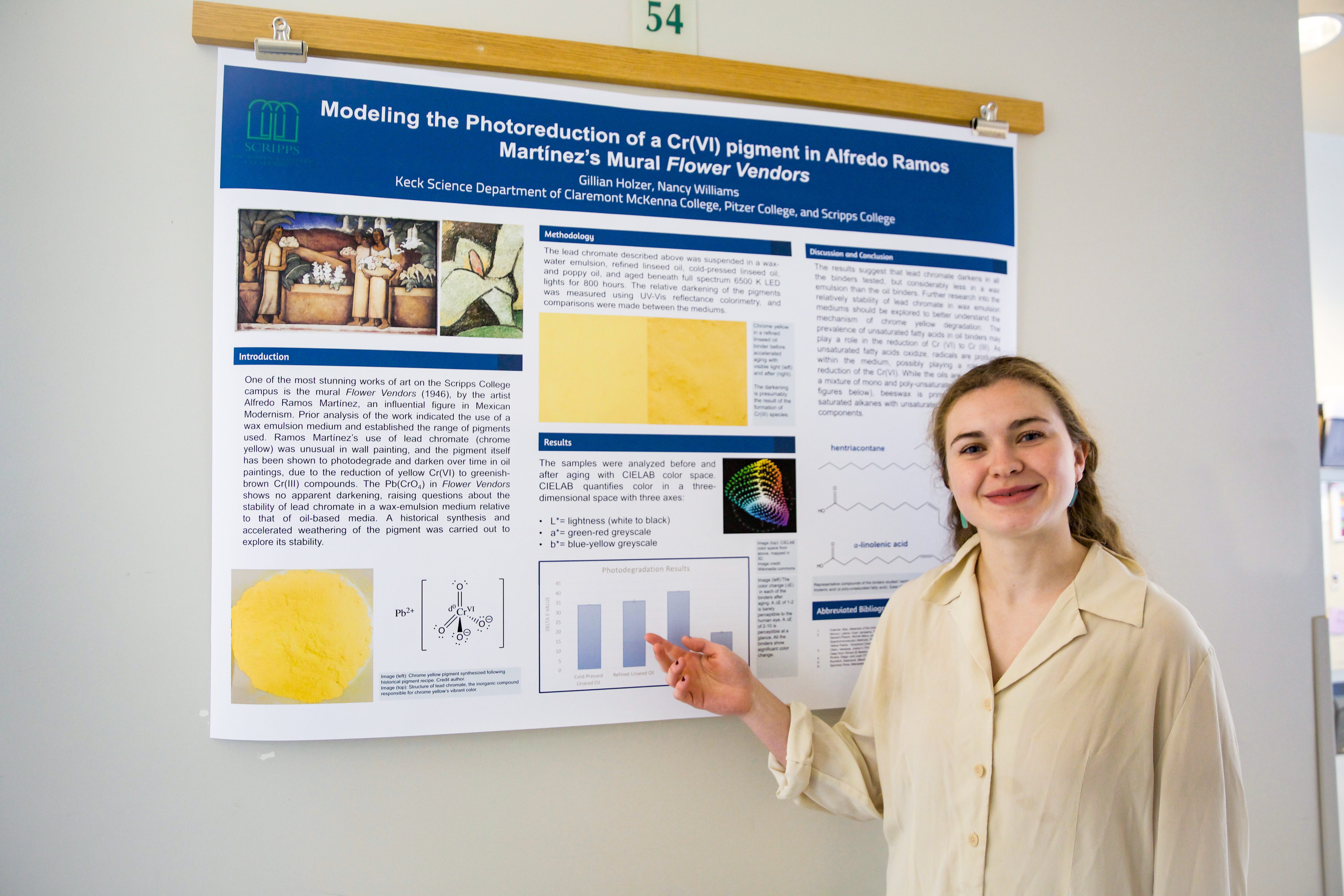
Vincent Van Gogh’s sunflowers are wilting.
In early 2018, news outlets around the world reported on chemical analyses performed by a team of Dutch and Belgian scientist that revealed that the sunflowers in Van Gogh’s famous paintings were degrading, turning from bright yellow to muddy olive green. The color Van Gogh used, a pigment called chrome yellow, was changing due to photosensitivity.
Across the Atlantic, in Scripps College’s Margaret Fowler Garden, chrome yellow is up to its old tricks, darkening other priceless artworks: The Flower Vendors murals (1946) by Mexican modernist Alfredo Ramos Martínez. Lucky for Scripps, the darkening is far less severe in Ramos Martínez’s murals than in Van Gogh’s paintings, and art conservation major Gillian Holzer ’19 is on the case.
Holzer first learned of the problem with chrome yellow in the summer of 2018, when the conservation team Zebala & Partners came to campus to clean the murals. Assisting on the project as an intern, she recalls, “Margaret Fowler Garden is a gem, and the murals are a huge part of that. The more I learned about the artist and what his few surviving pieces were facing, the more I wanted to know.”
Because of the published research on Van Gogh’s Sunflowers, Holzer already had an idea of how chrome yellow powder reacts when it’s mixed with oil and then applied to a canvas surface as paint. But Ramos Martínez used a wax emulsion for his murals in Margaret Fowler Garden, a technique he and other Mexican muralists had begun to innovate at the beginning of the 20th century. So Holzer devised a senior thesis project to re-create the conditions of chrome yellow degrading in an oil medium, as in Van Gogh’s paintings, and in a wax emulsion, as in Ramos Martínez’s murals, in order to fill a gap in knowledge about why this persnickety pigment is darkening in the Sunflowers but not so much in The Flower Vendors. She exposed oil and wax samples to 800 hours of full-spectrum LED lights and found that within the wax emulsion, the chrome yellow degraded at half the rate as within the oil emulsion.
“I am so excited that I got statistically significant results that very clearly show that the chrome yellow mixed in oil binders darkened twice as much as in the wax emulsion medium,” she explains. “From a chemical perspective, this is not surprising, but it emphasizes a bias in art history: Mexican modern artists were using a more stable medium, yet their methods are wildly understudied. The field tends to focus on European artists, and yet here were all of these other artists actually improving upon European methods.”
Holzer’s conclusions rank among the rare types of discoveries usually made by professors and researchers. But her combination of inquisitiveness, grit, and the unique tutelage she received from the interdisciplinary faculty of the art conservation major enabled her to do the professional-level work that expands the knowledge bases within the fields of art history and conservation.
“I knew coming into Scripps that I enjoyed interdisciplinary fields, especially the sciences with the humanities. My older sister, Iris Holzer ’17, also went to Scripps and recommended the art conservation major. I jumped right into general chemistry and an advanced art history course and, once I got hands-on experience, I was hooked and never looked back,” says Holzer.
“Professor of Art History Mary MacNaughton and the whole staff at the Ruth Chandler Williamson Gallery have been so helpful, and there’s no way I could have done this without the support and training of Associate Professor of Chemistry Nancy Williams, who took me under her wing and helped me conduct original research.”
This summer, Holzer will continue her internship at the Los Angeles County Museum of Art and then embark on an archaeological dig in the Peruvian Andes, helping with the expedition’s conservation effort, eventually making her way to a graduate program in art conservation, where she will continue to satisfy her burgeoning interest in cultural heritage and preservation.
“Preservation and conservation are so fascinating and important, because how we engage with our material heritage is fundamental to our identities,” she says. “Material cultural heritage shapes our sense of history and our sense of the future, both as individuals and collectively.”

